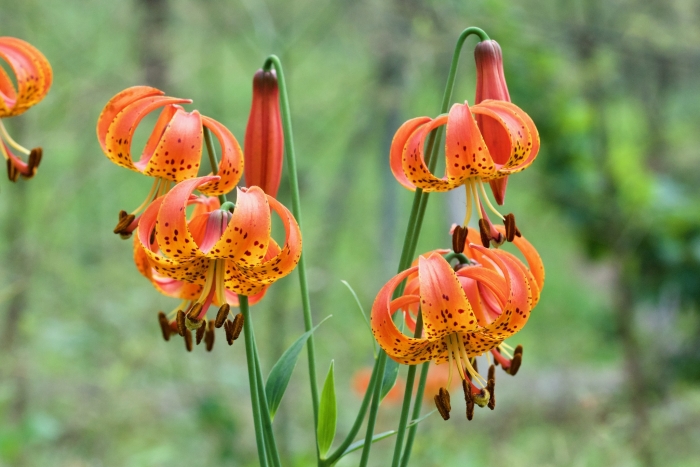Michigan Lily
(Lilium michiganense)
Michigan Lily (Lilium michiganense)
/
/

Owen Strickland
CC BY 4.0
Image By:
Owen Strickland
Recorded By:
Copyright:
CC BY 4.0
Copyright Notice:
Photo by: Owen Strickland | License Type: CC BY 4.0 | License URL: http://creativecommons.org/licenses/by/4.0/ | Rights Holder: Owen Strickland | Publisher: iNaturalist | Date Created: 2021-06-28T14:27:19-07:00 |


















































Estimated Native Range
Summary
Lilium michiganense, commonly known as Michigan Lily, is a deciduous perennial herb native to moist meadows, marsh edges, and damp prairies in the North-Central and Northeastern United States. This bulbous herbaceous perennial can reach a height of 5 feet (1.5 meters) and a spread of 2 feet (0.61 meters). The Michigan Lily is noted for its striking summer blooms, which are typically orange with dark brown spots and feature acutely recurved petals that add to their ornamental appeal. The flowers are quite showy and attract pollinators such as butterflies and hummingbirds.
The Michigan Lily is valued for its vibrant flowers and is often used in perennial borders, wildflower gardens, and naturalized areas. It thrives in full sun to part shade and prefers consistently moist, well-drained soils rich in organic matter. While adaptable to various soil types, it does best in soils with medium to fast drainage. Regular watering is important, especially during dry spells. Gardeners should be aware that the Michigan Lily can be susceptible to lily leaf beetle infestations and should monitor for this pest. Despite this potential issue, the plant’s beauty and ability to naturalize make it a desirable addition to many gardens.CC BY-SA 4.0
The Michigan Lily is valued for its vibrant flowers and is often used in perennial borders, wildflower gardens, and naturalized areas. It thrives in full sun to part shade and prefers consistently moist, well-drained soils rich in organic matter. While adaptable to various soil types, it does best in soils with medium to fast drainage. Regular watering is important, especially during dry spells. Gardeners should be aware that the Michigan Lily can be susceptible to lily leaf beetle infestations and should monitor for this pest. Despite this potential issue, the plant’s beauty and ability to naturalize make it a desirable addition to many gardens.CC BY-SA 4.0
Plant Description
- Plant Type: Herb, Bulb
- Height: 2-5 feet
- Width: 1-2 feet
- Growth Rate: Moderate
- Flower Color: Orange
- Flowering Season: Summer
- Leaf Retention: Deciduous
Growth Requirements
- Sun: Full Sun, Part Shade
- Water: Medium
- Drainage: Fast, Medium
Common Uses
Bee Garden, Bird Garden, Butterfly Garden, Hummingbird Garden, Low Maintenance, Showy Flowers, Water Garden
Natural Habitat
Native to moist meadows, marsh edges, and damp prairies in the North-Central and Northeastern United States
Other Names
Common Names: Lis Du Michigan
Scientific Names: Lilium michiganense , Lilium michiganense var. umbelliferum , Lilium michiganense var. uniflorum , Lilium canadense var. umbelliferum , Lilium michiganense f. uniflorum , Lilium canadense f. uniflorum , Lilium canadense subsp. michiganense , Lilium michiganense f. umbelliferum
GBIF Accepted Name: Lilium michiganense Farw.